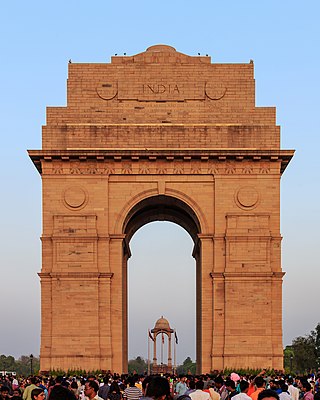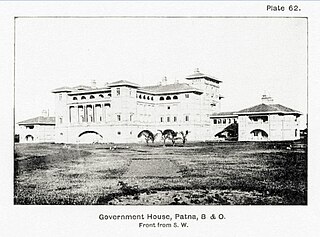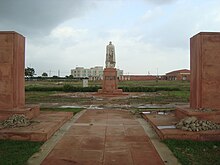
Emperor or Empress of India was a title used by British monarchs from 1 May 1876 to 22 June 1948 to signify their sovereignty over the British Raj as its imperial head of state. The image of the emperor or empress appeared on Indian currency, in government buildings, railway stations, courts, on statues etc. Oaths of allegiance were made to the emperor or empress and the lawful successors by the governors-general, princes, governors, commissioners in India in events such as imperial durbars.

The Governor-General of India was the representative of the monarch of the United Kingdom in their capacity as the Emperor/Empress of India and after Indian independence in 1947, the representative of the Monarch of India. The office was created in 1773, with the title of Governor-General of the Presidency of Fort William. The officer had direct control only over his presidency but supervised other East India Company officials in India. Complete authority over all of British territory in the Indian subcontinent was granted in 1833, and the official came to be known as the "Governor-General of India".

Edward Robert Lytton Bulwer-Lytton, 1st Earl of Lytton, was an English statesman, Conservative politician and poet who used the pseudonym Owen Meredith. During his tenure as Viceroy of India between 1876 and 1880, Queen Victoria was proclaimed Empress of India. He served as British Ambassador to France from 1887 to 1891.

The Most Exalted Order of the Star of India is an order of chivalry founded by Queen Victoria in 1861. The Order includes members of three classes:
- Knight Grand Commander (GCSI)
- Knight Commander (KCSI)
- Companion (CSI)

The Imperial Order of the Crown of India is an order in the British honours system. The Order was established by Queen Victoria when she became Empress of India in 1878. The Order was open only to women, and no appointments have been made since the Partition of India in 1947. The Order was limited to British princesses, wives or female relatives of Indian princes and the wife or female relatives of any person who held the office of:
Events in the year 1911 in India.

Charles Hardinge, 1st Baron Hardinge of Penshurst, was a British diplomat and statesman who served as Viceroy and Governor-General of India from 1910 to 1916.

The Rashtrapati Bhavan is the official residence of the President of India at the western end of Rajpath, Raisina Hill, New Delhi, India. It was formerly known as Viceroy's House and constructed during the zenith of British Empire. Rashtrapati Bhavan may refer to only the 340-room main building that has the president's official residence, including reception halls, guest rooms and offices, also called the mansion; it may also refer to the entire 130-hectare (320-acre) Presidential Estate that additionally includes the presidential gardens, large open spaces, residences of bodyguards and staff, stables, other offices and utilities within its perimeter walls. In terms of area, it is the second largest residence of any head of state in the world after Quirinal Palace in Italy. The other presidential homes are the Rashtrapati Nilayam in Hyderabad, Telangana and The Retreat Building in Shimla, Himachal Pradesh.

The India Gate is a war memorial located near the Kartavya path on the eastern edge of the "ceremonial axis" of New Delhi, formerly called Rajpath. It stands as a memorial to 74,187 soldiers of the Indian Army who died between 1914 and 1921 in the First World War, in France, Flanders, Mesopotamia, Persia, East Africa, Gallipoli and elsewhere in the Near and the Far East, and the Third Anglo-Afghan War. 13,300 servicemen's names, including some soldiers and officers from the United Kingdom, are inscribed on the gate. Designed by Sir Edwin Lutyens, the gate evokes the architectural style of the ancient Roman triumphal arches such as the Arch of Constantine in Rome, and later memorial arches; it is often compared to the Arc de Triomphe in Paris, and the Gateway of India in Mumbai.

The Delhi Durbar was an Indian imperial-style mass assembly organized by the British at Coronation Park, Delhi, India, to mark the succession of an Emperor or Empress of India. Also known as the Imperial Durbar, it was held three times, in 1877, 1903, and 1911, at the height of the British Empire. The 1911 Durbar was the only one that a sovereign, George V, attended. The term was derived from the common Persian term durbar.

Durbar is a Persian-derived term referring to the noble court of a king or ruler or a formal meeting where the king held all discussions regarding the state. It was used in South Asia for a ruler's court or feudal levy as the latter came to be ruled and later administered by foreigners. A durbar may be either a feudal state council for administering the affairs of a princely state, or a purely ceremonial gathering, as was increasingly the case during British rule in India.
Sir Ram Singh KCIE was the Maharaj-Rana of Dholpur from 1901 until his death in 1911.

Raj Bhavan is the official residence of the governor of the Indian state of Bihar. It is located in the state capital of Patna. Construction started in 1912 and was completed in 1917. It was designed by New Zealand-born architect Joseph Fearis Munnings.

Kingsway Camp, officially Guru Teg Bahadur Nagar since 1970, is a historic area located in North West Delhi, near Civil Lines and Delhi University. It starts from Guru Teg Bahadur Nagar (GTB) intersection, and has residential areas like Hudson Lines and Outram Lines. Neighboring localities include Dhaka Village, Mukherjee Nagar and Hakikat Nagar. The foundation of the new capital of British India, New Delhi, was laid at Coronation Park by King George V in December, 1911, making this area historically significant.
Events in the year 1912 in India.

Winifred Selina Hardinge, Baroness Hardinge of Penshurst, CI was a British aristocrat, courtier and Vicereine of India.

Maharaja Himmat Singhji was the last ruler of the princely state of Idar State. He was Maharaja of Idar from 1931 to 1948.

The Statue of Queen Victoria, Bangalore, is located at Queen's Park, next to Cubbon Park, Bangalore Cantonment, at the junction of 3 roads, at the border between the Cantonment and the Bangalore Pete. The statue was unveiled on 5 February 1906 by the then Prince of Wales, George Frederick Ernest Albert. The statue was raised out of funds raised by the residents of the Bangalore Civil and Military Station and contributions made by Krishna Raja Wadiyar IV, the Maharaja of Mysore. This Statue of Queen Victoria is one of the five of the original 50 statues of Queen Victoria which were installed in British India, to still stand at its original location. The statue has blossoms of jacaranda falling around. On the other end of Queen's Park is the Statue of King Edward VII.
Hardinge Park officially known as Shaheed Veer Kunwar Singh Azadi Park is a public park in the city of Patna built by British Raj in 1916. The park was initially named after Viceroy Charles Hardinge and was built in his honour as he was instrumental in the creation of Bihar as a separate province. It was built as Patna's first public park. The park is located midway between Patna Junction and the Bihar Secretariat. The name was changed to Shaheed Veer Kunwar Singh Azadi Park post independence. The park also hosted a garden party for then Prince of Wales - Edward VIII - in 1921 on his visit to Patna. The park completed its centenary in 2016. It is known as the old bus stand. Indian Railways is soon going to construct Suburban Rail Terminal at Hardinge Park which is barely 900 metres west from Patna Junction.
William Robert Mustoe was a Kew-trained English gardener and landscaper involved in the layout of gardens and avenues best known for his work in planning the gardens and avenues of the new capital city of Delhi, working in association with the architect Edwin Lutyens.



























